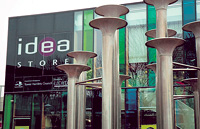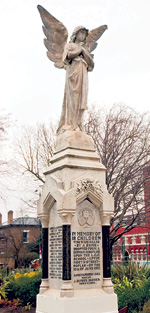In the footsteps of the dragon
By Graham Barker. Photos by Mike Askew
22 February

Download a brochure and map for this walk
Brighten up a grey and chilly winter’s day with a dash of colour. On this walk you’ll spot silver trumpets, a white angel and vibrant murals, wander through green churchyards and parks, and discover a mini East
End woodland with snowdrops.
Our walk starts at All Saints DLR station, in the heart of Poplar. Before heading off on the main route, it’s worth a quick detour to All Saints Church (1), built in 1823. So, as you leave the station turn right to Newby Place and you’ll soon see the sleek white spire. If the gates are open, loop around the church on the circular garden path for a closer look.
Now retrace your steps to the DLR station. Cross East India Dock Road at the lights and veer left into a small square. There’s a good view back to the art deco-fronted old Poplar Baths here. And ahead you’ll see a cluster of upright silver trumpets next to the blue and green glass of Chrisp Street Idea Store (2) – one of four in the borough offering books, DVDs, internet access, classes and activities.
Head along the central pedestrianised walkway between the shops to reach Chrisp Street Market (3), a place to snap up a bargain, have a coffee or pop to the loo. After a browse around, go left past the post office and left again along Kerbey Street back to the main road.
 On the right-hand corner, skirt around the former George Green’s School (4), now part of Tower Hamlets College specialising in financial education. George Green was a prosperous Poplar shipbuilder who used his wealth to establish sailors’ homes, almshouses and several schools. This one, with its ornate brickwork, was built in 1884 and the projecting blue clock added in 1928.
On the right-hand corner, skirt around the former George Green’s School (4), now part of Tower Hamlets College specialising in financial education. George Green was a prosperous Poplar shipbuilder who used his wealth to establish sailors’ homes, almshouses and several schools. This one, with its ornate brickwork, was built in 1884 and the projecting blue clock added in 1928.
Head over the pedestrian crossing, turn right and just beyond the bus stop enter Poplar Park (5).
By the circular garden the hauntingly beautiful Angel Memorial commemorates 18 schoolchildren killed in June 1917 during the first daylight air raid on London. Keep on the main path – past the adventure playground, raised grass spiral and plane trees – towards Canary Wharf towering in the distance.
As you walk, you get a fine view of St Matthias Church (6). The East India Company – wealthy from importing tea, spices, indigo and silk – built their company chapel here in 1654. Much of what we now see is Victorian, but the interior is most remarkable – one of only three churches built during Oliver Cromwell’s Commonwealth. Outside, there are well-preserved headstones with nautical motifs. Silver cut-out wall disks, created by community groups, mark the Poplar Heritage Trail.
Exit the park beside the black wooden pavilion and at Poplar High Street head right, past the bowling green. Just after Hale Street, cross to Tower Hamlets College (7) – usually lively with students – and then veer immediately right through a wooden slatted screen. This takes you on a short woodland walk, brightened with snowdrops at this time of year. You emerge to face the Will Crooks arch (8). Crooks was a local trade unionist and MP, noted for campaigning against poverty and inequality.
Keep on the left-hand pavement, past shops and school railings. You’ll soon spot a white horse (9) on a tall post, at the corner with Saltwell Street. The White Horse pub that stood here was home for 36 years to Mary East, a Georgian woman who lived apparently as a married man. She overcame blackmail threats, became a local dignitary and earned the epitaph ‘Mary East, the man-woman of Poplar’.

Head straight on, along the paved path into Pennyfields, a once-crowded street leading to old Chinatown. Local street names hereabouts – Ming, Canton and Pekin – ring of the Orient, though these days it’s hard to believe that this was once the heartland of the Chinese community in London. Chinatown flourished from the 1860s to 1940s – with restaurants, laundries and the occasional opium den – until dispersed by street widening schemes and Blitz bombing.
As you emerge on to West India Dock Road turn right – heading towards St Anne’s Church tower in the distance. Just before the Oporto pub, cross via a series of crossings, and continue onwards. Soon you’ll encounter Dragons’ Gate (10), a pair of lustrous metallic dragons on high. “Biting each other’s tails, they embody the power and unity of renewal” explains the plaque underneath.
After several more side streets you reach Beccles Street. On the corner is the Sailors’ Palace (11), built in 1901 for the British & Foreign Sailors’ Society and now a housing association. The figurehead holding two ships, each blown by a cherub, forms one of the finest art nouveau facades in the East End.
Escape the traffic by heading left along Three Colt Street and then through St Anne’s churchyard (12).
As you curve around Nicholas Hawksmoor’s impressive church, look back to the terracotta-fronted former Limehouse Church Institute. A curious stone pyramid, beyond the church steps, is inscribed with the Wisdom of Solomon and was originally intended to top off the church tower.
Leave St Anne’s through the main gates. Occasionally you may find the gates locked, in which case backtrack to Three Colt Street, skirt left around the railings on Commercial Road and turn first left into Newell Street.
Outside the church gateway, head straight on, over cobbles and follow the sign to Limehouse Basin. Step down to Limehouse Cut – a straight section of canal connecting Limehouse Basin with the River Lea – and follow it left under the DLR bridge.
Cross over the second footbridge, just as the canal widens out into the basin, enjoying the great two-way view as you go. Now follow the dockside round. Along the way, look out for the Limehouse Gallery tucked away in the corner and the Limehouse Accumulator (13) brick tower, built in 1869 to provide hydraulic power for cranes and locks in the basin. Keep by the water’s edge, sloping down as you go, for a closer view of the boats and birdlife.
As you curve round, you’ll come to a wavy suspension bridge (14) spanning the entrance lock and weir of Regent’s Canal. Cross over and the wide driveway ahead takes you to Limehouse DLR, the end of our walk.
With thanks to Rachel Maile for trialling this walk.
Download a brochure and map for this walk.